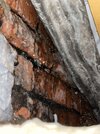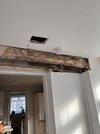This is what I thought, but eveything under the lead seems dry. To me, it looks like it’s soaking thru the render and the internal lintel is only wet because the bricks running a cross it are acting like a bridge for the water. I’m Really confused at where it’s coming from.it all points to flashing and or tiles. Maybe something under the window lintel but if the wall itself has dried out then my guess is one of the first options.
You are using an out of date browser. It may not display this or other websites correctly.
You should upgrade or use an alternative browser.
You should upgrade or use an alternative browser.
Water ingress with heavy rain.
- Thread starter adamm1
- Start date
Sponsored Links
It’s a stone window sil, but can’t see any cracks of gaps anywhere?Is that a wooden or a concrete exterior window sill?
Either one looks like work needs doing to it.
I meant the upstairs window on the outside: it looks crumbled and chipped.It’s a stone window sil, but can’t see any cracks of gaps anywhere?
As in the sealant looks crumbled or chipped? Or the window sil? You previous asked if the window sil was wooden or wooden. Thanks!I meant the upstairs window on the outside: it looks crumbled and chipped.
Sponsored Links
The concrete looks chipped and crumbly. Up to you.As in the sealant looks crumbled or chipped? Or the window sil? You previous asked if the window sil was wooden or wooden. Thanks!
It’s stone, I think the photo makes it look worse as the old paint is coming off. The edges of the sil are naturally chipped for effect.. do you think water could be coming in from somewhere on the cil?The concrete looks chipped and crumbly. Up to you.
Nine times out of ten (assuming the lean-to roof flashing is sound?) this will be water penetration around the window. Penetrating water through masonry is very, very rare, and I've only really seen it where masonry is completely saturated by high levels of running water from gutters etc. over a long period of time. In such case it would be obvious - the masonry would be heavily stained with algae.
This assumes the lean-to is sound and a decent flashing depth - a photo of the rainwater outlet and flashing over the lean-to would be useful.
This assumes the lean-to is sound and a decent flashing depth - a photo of the rainwater outlet and flashing over the lean-to would be useful.
Thanks for this! I will take more photos and attach them in around 15 minutes. I hope you can see something I can’tNine times out of ten (assuming the lean-to roof flashing is sound?) this will be water penetration around the window. Penetrating water through masonry is very, very rare, and I've only really seen it where masonry is completely saturated by high levels of running water from gutters etc. over a long period of time. In such case it would be obvious - the masonry would be heavily stained with algae.
This assumes the lean-to is sound and a decent flashing depth - a photo of the rainwater outlet and flashing over the lean-to would be useful.
Thanks for this! I will take more photos and attach them in around 15 minutes. I hope you can see something I can’t
Hi mate, iv attached several photos. The cleared cavity downstairs is where the leak is. And iv also taken photos of the upstairs box room window, as you can see there’s an old damp patch on the floor from around 10 days ago. This started drying out, but now we’ve have more heavy rain today the internal wall has started to get wet again. Iv attached photos so you can see. The photo showing water droplets are the external skin of the upstairs wall.Nine times out of ten (assuming the lean-to roof flashing is sound?) this will be water penetration around the window. Penetrating water through masonry is very, very rare, and I've only really seen it where masonry is completely saturated by high levels of running water from gutters etc. over a long period of time. In such case it would be obvious - the masonry would be heavily stained with algae.
This assumes the lean-to is sound and a decent flashing depth - a photo of the rainwater outlet and flashing over the lean-to would be useful.
The upstairs window isn’t directly inline with the downstairs door where we have the leak, so iv taken a photo of the Downpipe which is directly above our door. If you need any more photos please ask!
Attachments
-
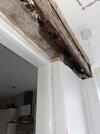 9714884D-5076-4AE0-A5C9-7BA2570EEFF9.jpeg229 KB · Views: 95
9714884D-5076-4AE0-A5C9-7BA2570EEFF9.jpeg229 KB · Views: 95 -
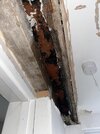 D496EA66-8BC9-4184-AA86-5CC29C0B93EC.jpeg292.2 KB · Views: 101
D496EA66-8BC9-4184-AA86-5CC29C0B93EC.jpeg292.2 KB · Views: 101 -
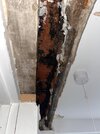 D439B252-9606-4540-AAFF-8B1D30134ED1.jpeg298.2 KB · Views: 102
D439B252-9606-4540-AAFF-8B1D30134ED1.jpeg298.2 KB · Views: 102 -
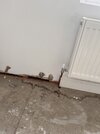 3357930B-219A-49A2-BF3B-A7CFB7485CD7.jpeg241.9 KB · Views: 98
3357930B-219A-49A2-BF3B-A7CFB7485CD7.jpeg241.9 KB · Views: 98 -
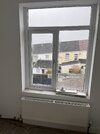 1DFD6E55-0F77-48B3-9300-B6C7D83FC1F2.jpeg250.1 KB · Views: 100
1DFD6E55-0F77-48B3-9300-B6C7D83FC1F2.jpeg250.1 KB · Views: 100 -
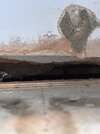 A03E10D4-07B6-4A81-957F-02830655F153.jpeg205.5 KB · Views: 89
A03E10D4-07B6-4A81-957F-02830655F153.jpeg205.5 KB · Views: 89 -
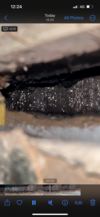 56E36FD5-F18C-4BAF-9DDA-033F602D32FD.png997.4 KB · Views: 101
56E36FD5-F18C-4BAF-9DDA-033F602D32FD.png997.4 KB · Views: 101 -
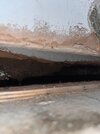 553BC9A8-D652-4325-B4E1-39A8E1DFBA66.jpeg210.3 KB · Views: 99
553BC9A8-D652-4325-B4E1-39A8E1DFBA66.jpeg210.3 KB · Views: 99 -
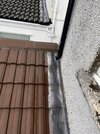 35002C99-C7D9-4FB9-9D42-4956D78A85B2.jpeg526.4 KB · Views: 100
35002C99-C7D9-4FB9-9D42-4956D78A85B2.jpeg526.4 KB · Views: 100 -
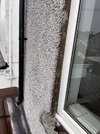 4CAA61E2-B0D0-4EE5-BF78-2045B9726D4A.jpeg510.7 KB · Views: 110
4CAA61E2-B0D0-4EE5-BF78-2045B9726D4A.jpeg510.7 KB · Views: 110
This is what is confusing me, upstairs as you can see from the photos it looks like a cavity wall because I can see the inner and out leafy brick work. But when I come downstairs I can’t see the cavity because there’s bricks over the lintel?You mention cavity - is it a cavity wall?
You say it is dry beneath the flashing. Does that include the small section of wall below the flashing but above the roof?
Regarding the wall, do you mean the wall in the roof space?
It’s hard to see, it’s very tight. But iv cut a hole in the ceiling which is below the lead line and the wall has drips? Iv also just been on the roof and there’s a hairline crack going from the window cil down to the lead, do you think this could be the issue? And also could it lead to that much water coming into the house?
It’s hard to see, it’s very tight. But iv cut a hole in the ceiling which is below the lead line and the wall has drips? Iv also just been on the roof and there’s a hairline crack going from the window cil down to the lead, do you think this could be the issue? And also could it lead to that much water coming into the house?
Attachments
DIYnot Local
Staff member
If you need to find a tradesperson to get your job done, please try our local search below, or if you are doing it yourself you can find suppliers local to you.
Select the supplier or trade you require, enter your location to begin your search.
Please select a service and enter a location to continue...
Are you a trade or supplier? You can create your listing free at DIYnot Local
Sponsored Links
Similar threads
- Replies
- 0
- Views
- 2K


